Category: Hunting Blog
Tough Conditions
It’s fawning season throughout most of the whitetail’s range. Current conditions have a huge impact on the survival and health of newborn fawns. Just like humans, the health of a deer while it’s a fawn is a determining factor of how much genetic potential it can express as an adult.
If the fawn is healthy and has all the resources (food, cover, water) it needs as a fawn, it has as good chance of expressing its full genetic potential as it matures. However, if the fawn is stressed by lack of quality food, fear of predation, or lack of water, its development will be hampered and it will likely not express its full genetic potential as it matures.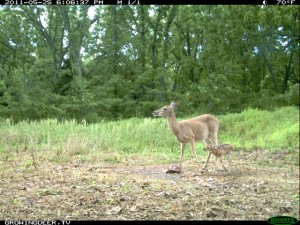
That’s why I monitor the weather, crop growth, and other factors this time of year as I plan future hunts. The current conditions this year in many areas haven’t been favorable for fawns. It’s very hot and dry in much of the southeast. It frosted last night in parts of Pennsylvania. Last week I had to wear a coat here in southwestern, Missouri and the temps are predicted to be above 90 degrees for the next seven days! West Texas, Oklahoma and other states have been experiencing a severe drought for several months.
There are always some pockets of ideal weather conditions throughout the whitetail’s range. This is one reason why huge bucks are killed in some areas for a few years and then that area returns to producing bucks with average antler size.
With all that said, I enjoy hunting properties I have a long-term relationship with the most. A mature buck is always a trophy, whether it has 140” or 180” of antler on its head. I’m a better predator on properties where I have experience. So, my chances of harvesting a mature buck are better on properties that I have a relationship with than hunting the latest “hot spot” where I don’t know the lay of the land.
When great growing conditions occur at the properties where I know the land this usually results in the best hunts for me. That obviously can’t happen every year. I set my expectations accordingly. For me the key to satisfying hunts is to hunt when and where I can with realistic expectations. I hope for good growing conditions, but learn how to be a better hunter and manager in all conditions.
Growing Deer together,
Grant
Creating Hidey Holes
Brad, Hunter, Nathan, and I scouted some areas for new Hidey Hole food plots today. Hidey Hole plots are small plots that are usually less than an 1/8th of an acre in size. I usually create them by using hand tools – no tractors or mechanical equipment. The ideal location for a Hidey Hole plot is an area where:
- Deer frequent
- Hunters can access without being detected by deer
- Wind direction usually remains constant (like a ridge top)
- It helps if no large trees need to be removed
We like to locate these areas this time of year to limit disturbance to the deer herd closer to season. In addition, we begin killing brush, etc., now with a herbicide so when we remove saplings they don’t sprout back. We kill any grass or broadleaf weeds with a herbicide so they will dry up before planting season.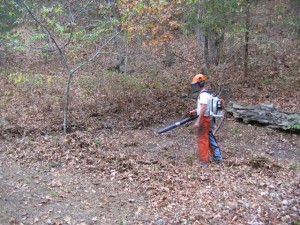
Just before planting the forage crop, I add ample fertilizer to help the forage crop grow rapidly and taste palatable to deer. For example, one 50 pound bag of 19 19 19 fertilizer applied to 1/8th acre is equivalent to applying 76 pounds of N, P, and K (400 pounds of 19 19 19) per acre. That’s usually enough to get a forage crop like wheat up and tasty for a month or two of great forage production. I plant the crop roughly three weeks before I anticipate hunting or the first frost. I also hang my Muddy stands and secure my Muddy SafeLine well before hunting season.
I try to avoid the area from when I plant until I hunt to allow deer to become conditioned to feeding in the area without being alert to two-legged predators. This is a critical step in creating a successful Hidey Hole food plot. In addition, I only hunt this location when the wind direction is appropriate. I don’t waste the effort spent creating the hotspot by allowing the local deer to associate the spot with human (predator) activity.
This is a great technique to see and harvest mature bucks that can be used on properties from ten to 1,000 acres. Hidey Hole food plots are not designed to increase the quantity of nutritious forage in an area, but to allow hunters to observe and harvest mature bucks at close range by providing high quality forage with minimal equipment and expense. Hidey Holes are a great tool to harvest mature bucks.
Growing Deer together,
Grant
Using Color to Predict Antler Growth Potential
In a blog entry earlier this week, Using Maps To Plan Where to Hunt this Fall, I shared a source of data from the NOAA in the form of a map that predicted precipitation or the lack of for the next few weeks in the Lower 48. Precipitation levels can be correlated with forage production and quality. Too much or too little precipitation can limit plants ability to transfer nutrients from the soil to deer.
Deer require high quality nutrition on a year round basis to express their full antler growth or fawn production potential. I doubt many free-ranging, wild deer express their full potential. The stress of avoiding predators, lack of quality forage, parasites, diseases, injuries, etc., all reduce a deer’s ability to express their full potential. Of these, it’s easiest for hunters to predict the quality of forage available when planning where to hunt during the upcoming season.
This time of year many whitetail and elk hunters are applying for tags in states where they are not residents. If antler potential is a factor of where you are deciding to hunt, I encourage you to study the following map based on NOAA data.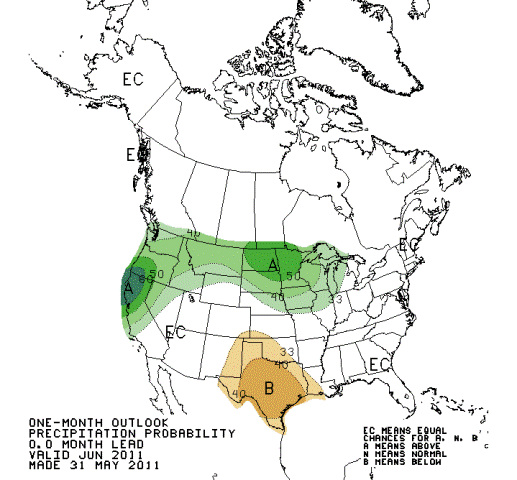
Precipitation amounts during spring green-up are critical to the antler development that year. Many forage plants (native and cultivated) are highest in digestible nutrients during the spring. If too much or not enough precipitation occurs during this time of year, the quality of forage and therefore quality of antlers can be reduced.
This is critical data to consider if you are planning an out of state hunt with the goal of harvesting a buck that has expressed a high percentage of his antler growth potential.
Based on the following map, most of west Texas, Oklahoma, and southwestern Kansas received way less than normal precipitation during the critical spring green-up period this year. Most of the Ohio River Valley and southern Missouri and Northern Arkansas received way more precipitation than normal during this same period of time. I suspect antler development will be less than average in both of these areas.
Much of the Midwestern corn belt received about the normal amount of precipitation during the same period of time. If this pattern continues throughout the summer, antler development should progress well in these areas.
Most of us have limited time and funds for hunting. By using the data from the map in this and the previous blog, those limited hunting days can be spent in areas where antler development may be the best this fall. Maps are one of the most useful scouting tools!
Growing Deer together,
Grant
Using Maps To Plan Where to Hunt this Fall
There has been much written about using maps to locate stand locations. I use topo maps, aerial images, etc., to learn the lay of the land, especially when hunting a new area. However, I study the NOAA Drought Indicator maps to plan which state or region to go hunting and to assist me with planning food plot strategies for both fall and spring.

NOAA’s drought indicator maps are available online and for free. They are maps that predict the amount of precipitation or lack thereof for the lower 48 states. It’s obvious why predictions of precipitation amounts are important for planting crops. It may not be obvious why I use them to plan where to hunt.
I’m not using them to plan where to hunt based on the chance of getting rained out! Those predictions are rarely accurate. Meteorologists rarely can predict precipitation three days out let alone three months out with accuracy. However, they are much better at studying ocean temperatures, currents, etc., and predicting general amounts of precipitation a region will receive. Precipitation is a key determinant of antler production.
You may recall that I frequently state in blogs and in episodes that plants are simply nutrient transfer agents. They can’t transfer nutrients to deer if the nutrients aren’t in the soil. If not enough precipitation occurs, the plants can’t use the available nutrients. Most folks associate drought conditions with poor forage quality. In fact, in south Texas there is great research that shows a very strong correlation between rain during the early spring and the average size of antlers per age class that year.
What hunters may not consider is that too much rain can be just as detrimental to antler growth as drought conditions. This is because too much rain can leach the nutrients in the soil deeper than the forage roots’ reach. When too much rain occurs in production ag fields, the farmers usually have to reapply fertilizer to make a productive crop. Still, the crop usually isn’t as productive (bushels per acre) or nutritious as the plants were not adequately fed during the period of above normal precipitation.
This year there are several areas that have received substantially more or less precipitation than normal. In both cases, there’s a good chance the native and cultivated forage there won’t be as nutritious as normal and as a result antler development will likely be less than average.
On the NOAA Drought prediction maps, I like to hunt areas that are white or light green (slightly above average precipitation) during the early spring through summer so antler production will likely be normal or above average for the area. The Proving Grounds has received a bit much rain so far this year, and that trend will likely continue based on NOAA’s predictions. Antler development may be hindered if predictions are accurate and especially if conditions are worse than predicted.
Based on this, how’s antler development looking for your area?
Growing Deer together,
Grant
A Spring Stressor for Me and the Deer Herd!
Brad had the following observations to share after running the trail cameras earlier today. – Grant
It’s raining cats and dogs here today at The Proving Grounds, a welcome sight since we were able to get all of our soybeans and corn planted earlier this week. Spring is the time of the year when we typically think deer have little stress due to the abundance of lush/nutritious native forage. The deer herd can definitely keep their belly full, but there are still plenty of stressors during this time of the year. The stressor that disturbs us every spring is the presence of a wad of ticks behind the ears of our bucks and does.
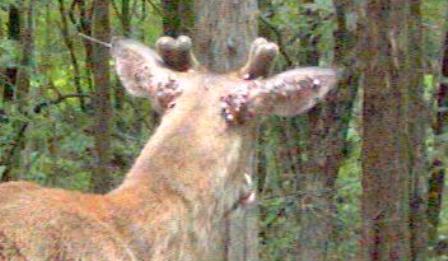
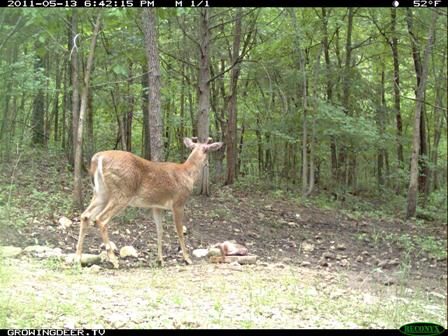 The area directly behind the deer’s ear is one of the few places on their body that the removal of unwanted ticks is difficult. If they do happen to find a way to scratch them off their skin often gets opened allowing for the possibility of infection.
The area directly behind the deer’s ear is one of the few places on their body that the removal of unwanted ticks is difficult. If they do happen to find a way to scratch them off their skin often gets opened allowing for the possibility of infection.
Ticks, as you can imagine, are also directly pulling from a deer’s energy and nutrient supplies. These resources are needed for developing antlers and rapidly growing fetuses. Not to mention the constant irritation can distract them from predator avoidance and normal foraging behavior.
The best method I know of to beat down tick populations is to keep a burning rotation going from year-to-year. Ticks are not easily consumed by the fire itself because they can burrow under debris or loose soil to escape the heat. However, they are susceptible to desiccation – or drying out. With much of the herbaceous and woody material removed, the soil surface can heat up more and lower ground level humidity levels cause ticks to die. In addition, ticks picked off are not simply flicked to the side or out the truck window, they meet their demise between a finger nail and a hard place or at the strike of a match.
I hope your deer are not suffering from ticks on your Proving Grounds, but if so consider implementing prescribed fires to help reduce their presence. It may pay dividends toward more venison in the freezer and larger antlers on the wall.
Growing Deer together,
Brad
Transfer Agents
During the past two decades, there’s been a huge increase in the percentage of hunters and landowners that plant crops for the purpose of attracting deer or providing them with a source of quality forage. Unfortunately, many of these great sportsmen seem to focus primarily on the plant, and not the plant’s purpose. Whether to attract deer or provide them with quality forage, plants fulfill this mission by being nutrient transfer agents.
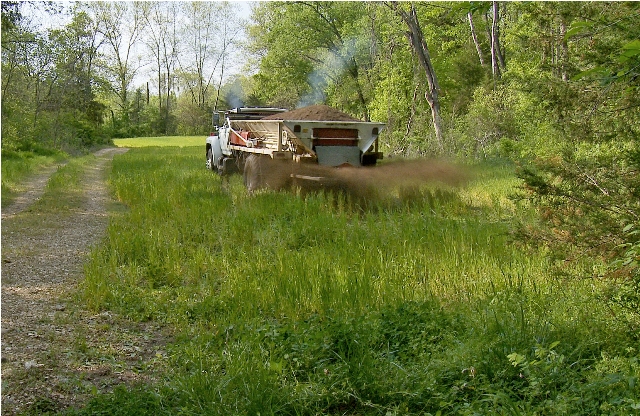 That is to say, plants transfer nutrients primarily from the soil to the deer. The only way this transfer can occur is if the nutrients are in the soil! Sportsmen tend to assume there are nutrients in the soil, especially if the plot is located in an area that produces agricultural crops. This assumption is usually not true. Even in areas with good quality soil like Iowa, successful farmers add nutrients (fertilizer) to the soil annually so the crops can transfer these nutrients from the soil and convert them into forage or grain. Farmers that don’t add the appropriate amount of fertilizer don’t produce a good crop.
That is to say, plants transfer nutrients primarily from the soil to the deer. The only way this transfer can occur is if the nutrients are in the soil! Sportsmen tend to assume there are nutrients in the soil, especially if the plot is located in an area that produces agricultural crops. This assumption is usually not true. Even in areas with good quality soil like Iowa, successful farmers add nutrients (fertilizer) to the soil annually so the crops can transfer these nutrients from the soil and convert them into forage or grain. Farmers that don’t add the appropriate amount of fertilizer don’t produce a good crop.
The same is true with food plot farmers. The ones that don’t insure there are adequate nutrients in the soil don’t produce a crop of deer that express their full genetic potential. It is food plot planting time throughout much of the whitetails’ range. However, just as important as selecting and planting the appropriate seed for the mission is to ensure the plot has the appropriate type and amount of nutrients available. For crops to be nutrient transfer agents there must be nutrients to transfer.
Growing Deer together,
Grant
Nikon Monarch Binoculars Made My Season
My 2011 turkey season was one of the best I’ve had. It was one of those years where I just happened to be hunting in the right place at the right time on several occasions. I truly believe the success of many of those hunts would not have been possible without the help of my Nikon Monarch binoculars. This was the first year I turkey hunted with a high quality set of binoculars. They were especially helpful when I was hunting open country. I was able to watch birds from a distance and figure out which ones were gobblers and which direction they were headed. From this information I was able to formulate a plan and set up nearby. From there my Derby City slate calls did the rest. My Nikon binoculars and Derby City calls will be part of my turkey gear for my future turkey seasons, that’s for sure!
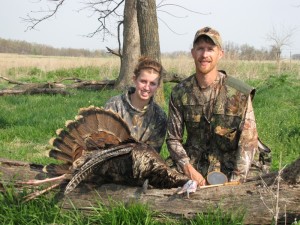
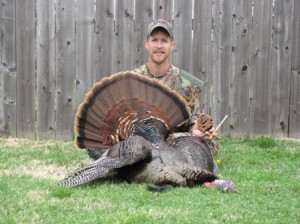
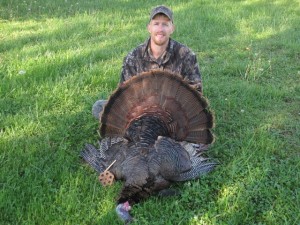
Growing Deer together,
Brad
Peak of Predation
Fawning and nesting season occurs at a great time of year. The temperatures are warming, and most vegetation is at its peak of both production and quality. It is the best time of year for deer, turkey, quail, and other game in many ways. It’s also the toughest time of year for these same species.
Coyotes and other predators are extremely skilled at consuming fawns, eggs, and poults. In fact, in many instances this is the time of year when losses to predation are at the highest. A coyote can kill multiple fawns. Several recent research projects have documented predators consuming 70+% of newborn fawns!! A single raccoon can destroy multiple turkey nests and consume dozens of eggs.
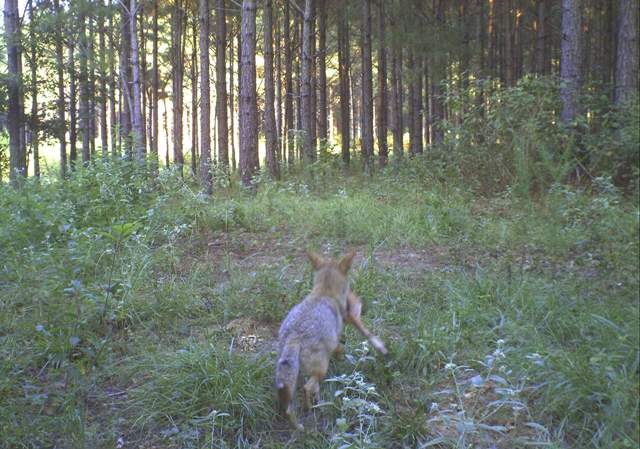
The old theory that as long as ample cover is available, predators are not a problem has been disproven by multiple well-designed research projects. However, hunters and managers should find encouragement in that significant increases (100+%) in fawn and poult survival have been reported in association with predator removal. These huge increases in fawn/poult survival are certainly enough evidence and motivation for me to practice predator control at The Proving Grounds and on my clients’ properties.
Calling coyotes is a great management tool and can be effective during the spring. Calling coyotes is one of the most enjoyable and exciting hunting techniques around. I can’t think of many activities that are better than an enjoyable hunt and knowing that I’m directly helping the local deer and turkey populations. I’ll be calling coyotes this spring so my family and I will continue to have quality hunting opportunities this fall. I hope you will join me in this important and fun wildlife management activity!
Growing Deer together,
Grant
Patience
Wild turkeys have had a low rate of nesting success during the past few years in portions of the Midwest. This is due to lots of rain during the nesting season and increased numbers of predators. There are still enough turkeys to hunt, but hunter success rates are decreasing.
This is not only because there are fewer gobblers compared to past years. A huge factor behind the declining hunter success rates is that there aren’t as many two year old gobblers present. Two year old toms tend to gobbler more than any other age class of gobblers. In addition, they tend to respond to calling by approaching rather than wait for the “hen” to come to them.
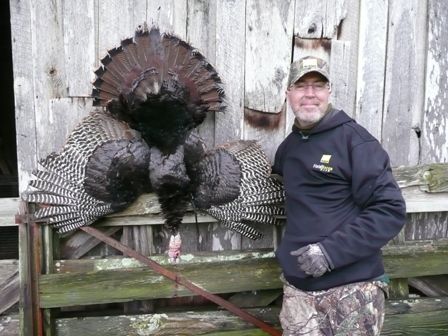 By contrast, three year old and older gobblers tend to gobble less and wait for hens to come to them. This is probably a predator defense tactic and given the increasing number of predators, this tactic may be used even more than during the past. It’s a simple matter of selection. Toms that gobble a lot and respond by approaching calling are harvested more frequently by predators and hunters than toms that wait for the hen to approach them.
By contrast, three year old and older gobblers tend to gobble less and wait for hens to come to them. This is probably a predator defense tactic and given the increasing number of predators, this tactic may be used even more than during the past. It’s a simple matter of selection. Toms that gobble a lot and respond by approaching calling are harvested more frequently by predators and hunters than toms that wait for the hen to approach them.
Because of this, it usually takes more patience and skill to harvest a three year old or older gobbler. I’ve been blessed to have had much success at harvesting three year old and older toms. My rate of success with these mature birds has increased as I’ve gotten older and I am less likely to move when a gobbler doesn’t approach my calling rapidly or stops gobbling.
I’m much more willing to call to a tom, get a response, then remain in place even if the tom doesn’t gobbler for an hour or more. Mature toms will certainly respond to and come to a call. However, they rarely run to a call while gobbling the entire way.
By getting a tom’s attention and remaining in an area where toms have been known to strut or frequent, mature gobblers will frequently approach without gobbling. The more patience I gain as I mature, the better a turkey hunter I’ve become. I’m still a huge fan of the cut and run turkey hunting technique. I simply don’t “run” as much as I did when I was younger. Less “running” has allowed me and my guests to put more turkey breast in the freezer.
A principle I was taught in college is that change is the only constant. The demographics of many turkey populations have changed and therefore it has been advantageous for me to change my hunting techniques. By combining biology and woodsmanship, I have plenty to eat besides tag soup!
Growing Deer together,
Grant
Good Genetics!
I often hear folks say “The deer have good genetics there!” They almost always say that because the deer “there” have bigger antlers, heavier body weights, etc. However, almost always the “there” is where crops such as corn or soybeans are produced. To know genetics requires knowledge of the pedigree (who bred who for several generations). That information is almost never available for critters from a free-ranging herd.
However, data that is easily obtainable is what deer and turkey are consuming. This is accomplished by simply checking the stomach or crop content of recently killed critters. Turkeys at The Proving Grounds have had body weights above average for the local area for several seasons. These elevated body weights were noticed after I began planting Eagle Seed forage soybeans and corn in the food plots. This spring, I’ve examined the crop content of every turkey we’ve harvested (five) to date. Each one included the seeds from the Eagle Seed forage beans. In fact, four of the five harvested only had soybean seed in their crops.
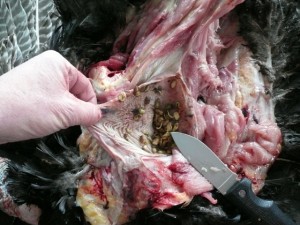 I remember an esteemed scientist stating at a conference many years ago “the best way to improve genetics is nutrition, nutrition, nutrition.” I would redefine that a bit and say there is no way to improve genetics of free-ranging wildlife. However, by significantly increasing the amount of high quality forage and grain available for consumption you can improve the body and antler size and the number of fawns recruited for free-ranging wildlife.
I remember an esteemed scientist stating at a conference many years ago “the best way to improve genetics is nutrition, nutrition, nutrition.” I would redefine that a bit and say there is no way to improve genetics of free-ranging wildlife. However, by significantly increasing the amount of high quality forage and grain available for consumption you can improve the body and antler size and the number of fawns recruited for free-ranging wildlife.
The Proving Grounds is in an area dominated by high-graded timber and fescue pasture. There are no production corn or soybean crops nearby. However, the wildlife we produce and harvest have similar body weights and antler size as critters in ag production areas. We’ve taken no steps to alter the genetics of our herds and flocks. We have grown quality grain and forage for their consumption. My neighbors probably think “the deer at The Proving Grounds have good genetics.” The local deer herd shares the same genetics. However, the deer at The Proving Grounds can express their genetic potential because of the quality forage and grain crops. Brad and I just returned from working on our no-till drill. To some, we were working on improving the genetics of the local deer and turkey populations.
Growing Deer together,
Grant



